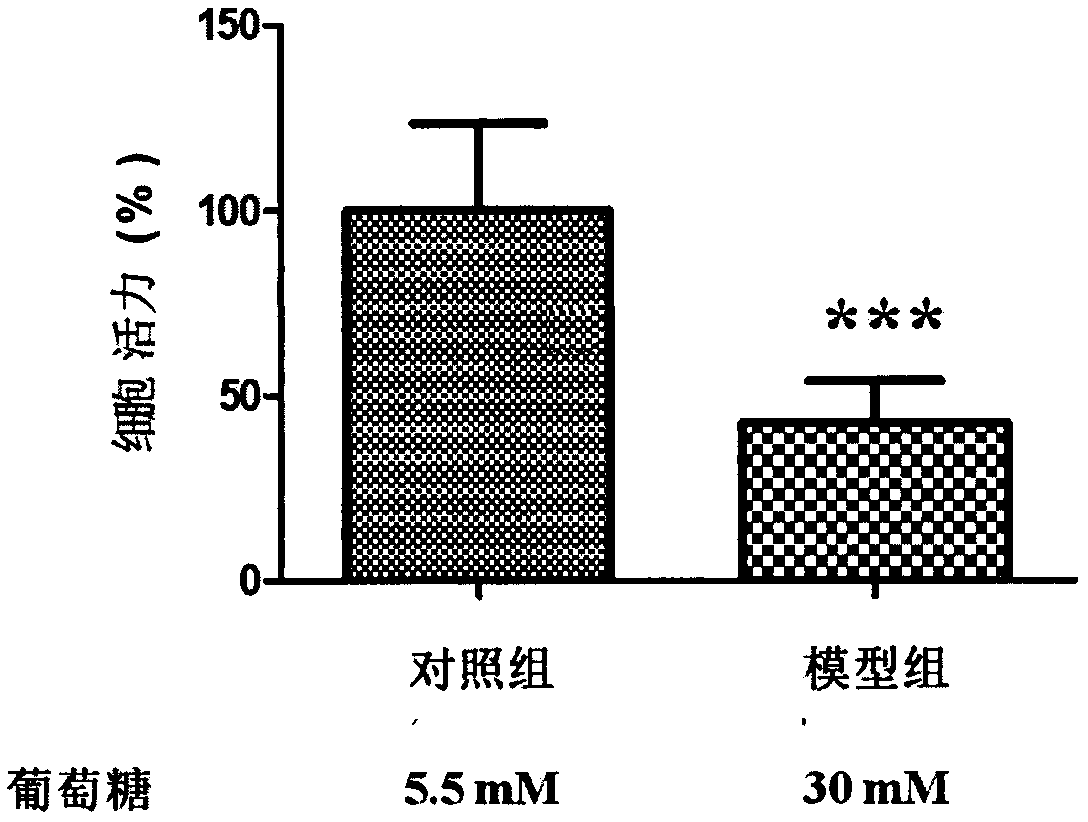Method for building diabetes model through inducing human liver cancer cells HepG2 by glucose and application
A technology of liver cancer cells and glucose, applied in metabolic diseases, active ingredients of heterocyclic compounds, drug combinations, etc., can solve the problems of unpublished diabetes models and unresearched effects of HepG2 cells.
- Summary
- Abstract
- Description
- Claims
- Application Information
AI Technical Summary
Problems solved by technology
Method used
Image
Examples
Embodiment example 1
[0019] HepG2 cells were placed in complete medium (1% double antibody, 1% Hepes 1M, 10% FBS, 5.5mM glucose) at 37°C, 5% CO 2 Cultivate them in an incubator until they are completely adhered to the wall. When the HepG2 cells adhere to the wall to about 80%, add 2 mL of trypsin and place in the incubator to digest for 2 minutes, prepare a suspension, drop it into the cell counting plate, count under the microscope, and adjust the cell concentration to 1×10 5 pieces / ml. Set up the control group and the model group, inoculate 100 μL per well in a 96-well plate, and culture in a 37°C incubator for 24 hours until the cells are 70% full. The supernatant was discarded, and 100 μL of incomplete medium (1% double antibody, 1% Hepes 1M, 5.5 mM glucose) was added for starvation culture for 4 hours to synchronize all HepG2 cells. The model group was stimulated by adding glucose solution with a final concentration of 30mM for 24 hours. According to the MTT assay, cell viability was measu...
Embodiment example 2
[0021] HepG2 cells were placed in complete medium (1% double antibody, 1% Hepes 1M, 10% FBS, 5.5mM glucose) at 37°C, 5% CO 2 Cultivate them in an incubator until they are completely adhered to the wall. When the HepG2 cells adhere to the wall to about 80%, add 2 mL of trypsin and place in the incubator to digest for 2 minutes, prepare a suspension, drop it into the cell counting plate, count under the microscope, and adjust the cell concentration to 1×10 5 pieces / ml. Set up the control group, model group, and experimental group, inoculate 100 μL per well in a 96-well plate, and culture in a 37°C incubator for 24 hours until the cells are 70% full. The supernatant was discarded, and 100 μL of incomplete medium (1% double antibody, 1% Hepes 1M, 5.5 mM glucose) was added for starvation culture for 4 hours to synchronize all HepG2 cells. Firstly, blueberry anthocyanin extract with a final concentration of 5 μg / mL was added to the experimental group for protection for 24 hours, a...
PUM
 Login to View More
Login to View More Abstract
Description
Claims
Application Information
 Login to View More
Login to View More - R&D Engineer
- R&D Manager
- IP Professional
- Industry Leading Data Capabilities
- Powerful AI technology
- Patent DNA Extraction
Browse by: Latest US Patents, China's latest patents, Technical Efficacy Thesaurus, Application Domain, Technology Topic, Popular Technical Reports.
© 2024 PatSnap. All rights reserved.Legal|Privacy policy|Modern Slavery Act Transparency Statement|Sitemap|About US| Contact US: help@patsnap.com









